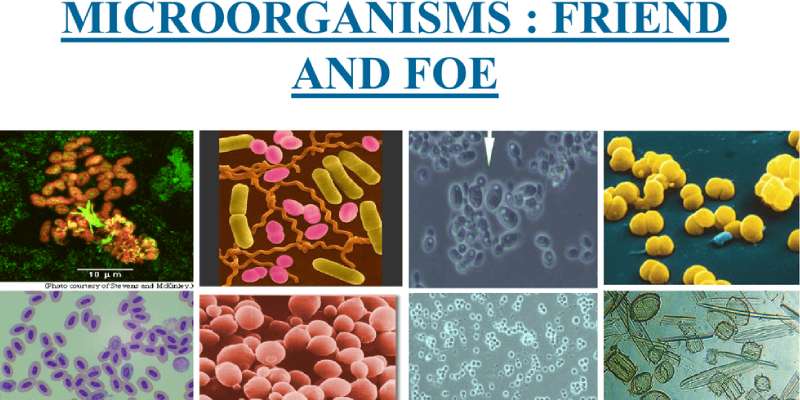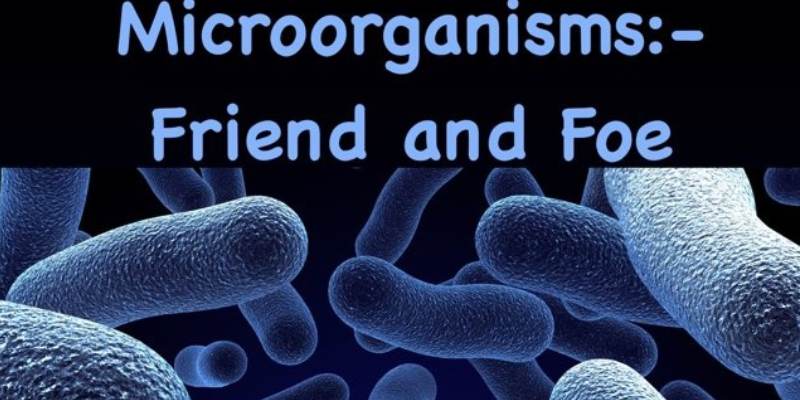Microorganisms broadly classified into bacteria, viruses, fungi, algae, and protozoa play essential roles in various ecosystems and our lives. Some of them are very helpful and considered friends and some of them are very dangerous for us and act as foes.
Question 1) What are microorganisms?
Answer: Microorganisms are tiny living organisms that are not visible to the naked eye. We can see it with the help of a microscope.
Explanation: Tiny living organisms can live in all kinds of environments, ranging from ice-cold climates to hot spring deserts and marshy lands. It may be unicellular or multicellular.
Question 2) What are viruses?
Answer: Viruses are microorganisms that reproduce only inside the cells of the host organisms: bacteria, plants, or animals.
Explanation: A virus is quite different from other microorganisms. Outside the body of the host, it is considered dead.
Question 3) Name some diseases caused by viruses.
Answer: Common diseases like colds, influenza (flu), and most coughs are caused by viruses. Serious diseases like polio, chicken pox, HIV/AIDS, and the pandemic covid are also caused by viruses.
Explanation: These diseases can affect various systems and organs in the body, leading to symptoms such as fever, cough, fatigue, muscle aches, respiratory distress, gastrointestinal issues, and more. The severity of the disease often depends on the specific virus involved, the individual's immune response, and other factors such as age and underlying health conditions.
Question 4) Which microorganism is Autotrophs?
Answer: Algae
Explanation: Algae utilize photosynthesis to produce their food, converting carbon dioxide and water into organic compounds using light energy. They play a crucial role in aquatic ecosystems and are a primary food source for many aquatic organisms. Their body is not divided into roots, stems, and leaves.
Question 5) What is bacteria?
Answer: Bacteria are single-celled microorganisms that can be seen only under a microscope. Their cells are prokaryotic.
Explanation: Bacteria are one of the most abundant and diverse forms of life on Earth and can be found in almost every environment, including soil, water, air, and other living organisms. Bacteria come in various shapes (such as spherical, rod-shaped, and spiral) and sizes, ranging from a few micrometers to tens of micrometers in length.
Question 6) What is fungi?
Answer: Fungi are non-green organisms. They cannot synthesize their food. They may be unicellular or multicellular.
Explanation: They are distinct from plants, animals, and bacteria and belong to their kingdom, Fungi. Fungi are a diverse group of eukaryotic organisms that include yeasts, molds, and mushrooms.
Question 7) What are antibiotics?
Answer: The medicines that kill or stop the growth of disease-causing microorganisms are called antibiotics.
Explanation: Antibiotics are primarily effective against bacteria and do not work against viral infections.
Question 8) Name some examples of bacteria.
Answer: Coccus, Bacillus, Spirillum, etc.
Explanation: Coccus is a bacteria that has a spherical or roughly spherical shape, Bacillus is a rod-shaped bacteria. They can vary in length and width but are generally cylindrical and Spirilla are bacteria that have a spiral or helical shape. They are often rigid and have a corkscrew-like appearance.
Question 9) Give some examples of Fungi.
Answer: Bread mold, Penicillium, and Aspergillus.
Explanation: Molds typically appear as fuzzy patches of black, green, or gray on the surface of bread, fruits, vegetables, and other organic materials. Penicillium fungi have a characteristic blue-green or bluish mold appearance and are commonly found on food items such as bread, cheese, fruits, and citrus fruits. Aspergillus is used in food fermentation processes, such as the production of soy sauce and sake.
Question 10) Name some Protozoa.
Answer: Amoeba, Paramecium, and Plasmodium.
Explanation: Amoeba is a single-celled organism belonging to the group of protozoa. It has a simple structure with a flexible cell membrane and a nucleus but lacks distinct organelles like mitochondria or chloroplasts. Amoebas are found in various aquatic environments, including freshwater ponds, streams, and soil.
Paramecia are heterotrophic organisms, feeding on bacteria and other small particles by sweeping them into their oral groove. They are commonly found in freshwater habitats like ponds, lakes, and slow-moving streams.
Plasmodium is a genus of parasitic protozoa that causes malaria, a potentially life-threatening disease transmitted by mosquitoes.

Question 11) Give some examples of Algae.
Answer: Chalmydomonas and Spirogyra.
Explanation: Chlamydomonas and Spirogyra are green algae commonly found in freshwater environments. Chlamydomonas is a single-celled alga with flagella for movement, while Spirogyra forms long chains of interconnected cells with spiral chloroplasts. Both algae undergo photosynthesis to produce their food and play important roles in freshwater ecosystems.
Question 12) Which microorganism is responsible for the formation of curd from milk?
Answer: Lactobacillus.
Explanation: Lactobacillus is a type of helpful bacteria. When you make curd or yogurt, you add these bacteria to milk. They eat the natural sugar in the milk, called lactose, and turn it into acid. This acid makes the milk thicker and tangy. It also makes the milk's proteins stick together, forming the solid texture of curd or yogurt. Lactobacillus bacteria are like little chefs that transform milk into curd by thickening it and giving it that yummy flavor.
Question 13) What is the function of the acetobacter acetic bacteria?
Answer: Acetobacter acetic bacteria is used for the production of acetic acid from alcohol.
Explanation: This bacteria is commonly used in the production of vinegar. When ethanol (alcohol) is exposed to oxygen, Acetobacter acetic bacteria oxidize it, turning it into acetic acid. This process gives vinegar its characteristic sour taste and acidic properties. Acetobacter acetic bacteria are responsible for turning alcoholic liquids into vinegar.
Question 14) What is the commercial use of Yeast?
Answer: It is used for the production of alcohol and wine by growing them on natural sugars present in grains like barley, wheat, rice, crushed fruit juices, etc.
Explanation: Yeast is like a tiny, living ingredient that's good at making things rise. In baking, it helps dough puff up by producing carbon dioxide gas, which creates bubbles and makes bread and cakes fluffy. But yeast also has a big job outside the kitchen. In industries like brewing and winemaking, yeast ferments sugar into alcohol and carbon dioxide, turning grape juice into wine or grains into beer.
Question 15) Which bacteria are known as biological nitrogen fixers?
Answer: Rhizobium bacteria.
Explanation: These bacteria have the remarkable ability to convert atmospheric nitrogen (N2) into ammonia (NH3) or other nitrogen compounds that plants can use for growth. This process is essential for maintaining soil fertility and the overall health of ecosystems, as it provides a vital source of nitrogen for plants, which are unable to use atmospheric nitrogen directly. It converts nitrates and nitrites present in the soil into nitrogen gas which is released in the atmosphere.
Question 16) Name some diseases caused by Protozoans.
Answer: Dysentery and malaria.
Explanation: Dysentery is like a really bad stomachache with super messy poops. It happens when your intestines get infected by germs, like certain bacteria or parasites. These germs make your tummy hurt a lot and give you diarrhea that's not only watery but also has blood or mucus in it.
Malaria is like a sneaky illness that mosquitoes pass on when they bite you. Inside your body, tiny parasites called Plasmodium start causing trouble. They make you feel feverish, tired, and achy all over, kind of like having a really bad flu.

Question 17) Name some diseases caused by Bacteria.
Answer: Typhoid and Tuberculosis (TB).
Explanation: Typhoid is a bacterial infection caused by a germ called Salmonella typhi. It spreads through contaminated food or water. When you get typhoid, you might have a high fever, stomach pain, headache, weakness, and sometimes a rash.
TB is a bacterial infection caused by a germ called Mycobacterium tuberculosis. It mainly affects the lungs but can also spread to other parts of the body. TB spreads through the air when someone with TB coughs or sneezes, releasing tiny germs into the air. When you breathe in these germs, they can settle in your lungs and make you sick. TB can cause coughing, chest pain, weight loss, fever, and tiredness.
Question 18) Name the disease caused by Fungi.
Answer: N. Homilus, Candida, and Mucor.
Explanation: Nocardia hominis can cause a rare but serious infection called nocardiosis in humans, especially in individuals with weakened immune systems. Nocardiosis usually affects the lungs, causing symptoms such as coughing, chest pain, and difficulty breathing. It can also spread to other parts of the body, leading to skin lesions, abscesses in the brain, or other serious complications.
Candida is a type of yeast (fungus) that commonly resides on the skin, mucous membranes, and in the gastrointestinal tract of healthy individuals
Mucor is a genus of molds belonging to the group known as mucormycetes. These molds are ubiquitous in the environment, particularly in soil, decaying organic matter, and food.
Question 19) What is the carrier?
Answer: The organisms that carry the pathogen from a diseased person to a healthy person are known as carriers.
Explanation: Female Anopheles mosquito which carries the parasite of malaria and also acts as a carrier of the dengue virus.
Question 20) Name some diseases caused by microorganisms in which the mode of transmission is only air.
Answer: Tuberculosis and measles.
Explanation: The causative microorganism of tuberculosis is bacteria; in measles, the causative agent is a virus. The preventive measures in both of them are complete isolation.
Question 21) Which mode of transmission takes place in chicken pox?
Answer: Air or contact.
Explanation: Chicken pox is caused by a virus and the preventive measure is complete isolation.
Question 22) Polio is caused by which microorganisms?
Answer: Polio is caused by a virus.
Explanation: The mode of transmission of polio is air and water. The preventive measure is vaccination at a suitable age and time.
Question 23) Which microorganism caused cholera?
Answer: Cholera is caused by bacteria.
Explanation: The transmission mode of cholera is contaminated water or food. The preventive measure is to maintain hygiene.
Question 23) By which mode of transmission does typhoid take place?
Answer: Water.
Explanation: The causative microorganism of typhoid is bacteria. The preventive measures are consuming properly cooked food and boiled water and vaccination.
Question 24) What are the preventive measures for preventing Hepatitis B?
Answer: Drink boiled water and vaccination.
Explanation: Hepatitis is caused by a virus and it is transmitted by water.
Question 25) Which microorganism caused malaria?
Answer: Malaria is caused by protozoa.
Explanation: The mode of transmission of malaria is mosquito and the preventive measures are to use mosquito nets and other methods to avoid the growth of the mosquito.
Question 26) Name the mode of the transmission of these plant diseases Citrus canker, Rust wheat, and Yellow vein mosaic in Bhindi.
Answer: The mode of the transmission of disease in Citrus canker is air, in Rust wheat is insect and seeds, and in Yellow vein mosaic in Bhindi is insect.
Explanation: Citrus canker is caused by bacteria, Rust wheat is caused by fungi and yellow vein mosaic of bhindi is a virus.
Question 27) What is food poisoning?
Answer: Food poisoning, also known as foodborne illness, is a condition caused by consuming contaminated food or water.
Explanation: Microorganisms that grow on our food sometimes produce toxic substances. It occurs when harmful bacteria, viruses, parasites, or toxins present in the food or water are ingested and cause illness.